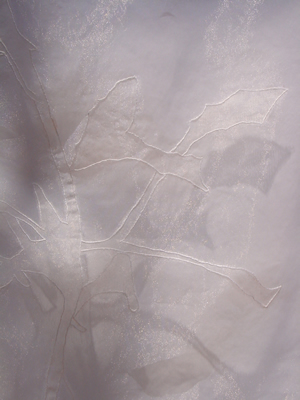
Endangered (Hutchinsia tasmanica), 100
x 45cm, organza hand stitched
2002 |
Louisa
Anne Meredith (1812-1895) Robyn Glade-Wright
chose to settle in Tasmania after several holiday visits from
Sydney. Tasmania’s natural beauty and the cool climate were
appealing qualities. Tasmania also had a vibrant arts culture
that included a number of well-known practising artists and
designers. Glade-Wright established a studio in Hobart producing
work for exhibition and commission. Following an invitation to
participate in an Arts Tasmania industries development programme
Glade-Wright took up the position as textile designer in a
woollen mill in Launceston.
She is currently researching modern day perceptions of
natural beauty and the tragedy of extinction. Her study
investigates how the loss of species from the natural world
escapes much of the post-industrial world’s attention as it
searches for gratification and fulfilment through the pursuit of
material wealth. Exploitation of ‘wild’ natural resources
invariably produces decline and extinction. This work poignantly
foregrounds the recent casualties and endangered species of
Tasmania. Importantly, it expresses the natural world as
vulnerable, fragile and complex and urges all of us to action a
compact of interdependence with nature.
Louisa Anne Meredith (1812-1895) a Tasmanian settler, wrote
extensively about her life on the east coast. Her writings often
mentioned concern for the natural world, specifically the fate
of the black swans. Meredith’s commentary went beyond the
publication of diaries and poetry. In 1884 she won an award for
an image of Tasmanian wildflowers embroidered in crewel work.
While Meredith celebrated the abundance, beauty and charm of
Tasmanian wildflowers in crewel work. Glade-Wright, on the other
hand, uses the same embroidery form to picture a different
condition. Her pre-occupation with natural beauty is to state
our responsibility to the preservation of flora through an
unsettling portent.
Robyn Glade-Wright 2002 |
